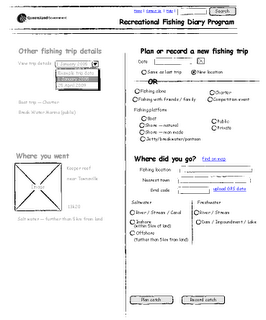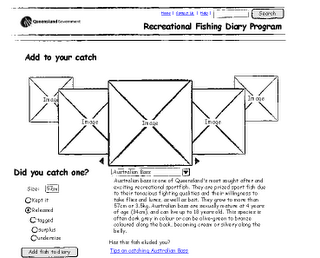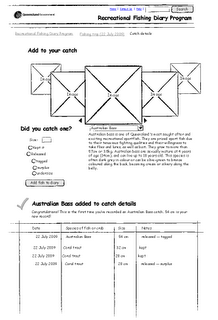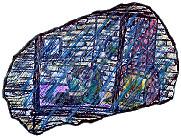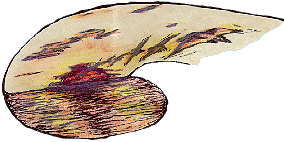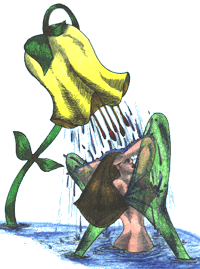Go fish!
We talk about fishing a bit at work — we did refresh the website for purchasing stocked impoundment permits (SIPS, they are for recreational fishing in Queensland dams) early in the year. Isn't that form pretty!?
In July, I started some wireframes for a new potential website: an online fishing diary. At the moment, recreational fishers can opt in to the diary scheme and keep a logbook of species they catch. These volunteers contribute meaningfully to fisheries management, as I understand it. Nice work citizens! We had hopes this would be an interesting new service. It has some relationship to the SIPS of course, but even more potential as a citizen engagement (or e-engagement, e-government, social networking etc.) For anglers. Smart Service is big into egovernment and engagement, particularly on the GetInvolved website. Yes the online fishing diary seemed ideal.
Here's some of the mockups, showcasing the initial exploration I began around collecting the diary entries:
A bit like surveys, but trying to really engage, you know? Rather than simply recording data, making it a bit more fun and competitive, maybe even educational. Does data have to be dry and dull? Can you see people that love fishing enjoying typing data into websites? Let's take a leaf from gaming — people love stats and achievements!
Sadly it was canned. Boo hiss! I've been meaning to write this eulogy since then.
Alas ye online fishing diary, put aside before you truly had a chance to shine.
Labels: design, government, UX, web, work
- The chance for comments is gone. Shame, 0 is never enough.
http://inspire.server101.com/ben/2009/11/go-fish.html
Easy rounded corners — playing nice with borders in IE6
When a graphic designer gives you a mockup full of rounded corners, you just know you’re in for some pain. Why can’t they be satisifed with Comic Sans fonts instead of delving into techniques that haven’t quite penetrated the user-agent landscape yet. Ah… just jokes of course!
 Andrew has published a technique dubbed “cornerise” over at irama, that neatly wraps up what we discovered when implementing rounded corners. As noted, border-radius does all the magic in newer builds of gecko and webkit, but that leaves us with a good chunk of Internet Explorer users needing some love—cornerise is such a technique.
Andrew has published a technique dubbed “cornerise” over at irama, that neatly wraps up what we discovered when implementing rounded corners. As noted, border-radius does all the magic in newer builds of gecko and webkit, but that leaves us with a good chunk of Internet Explorer users needing some love—cornerise is such a technique.
It works by using javascript to insert some tactically placed <span> tags into a document. These spans are positioned in the corners, and background images provide the corners. The overall footprint can be kept lean by utilising css sprites (like this one).
If you happen to be using borders with corners, you have a bit more to do. Firstly, the background images must include a border strip the same size as the border — pixel widths only here. Secondly, the corners need to be positioned on top of the border which means moving them slightly beyond the bounds of the containing box. Thirdly, you will enounter a quirk in IE6 that results in a 1 pixel border on the right or bottom of the box. Try as you might you won’t get rid of it — without compromising the corners in IE7 and IE8 that is! Actually, this quirk presents even without borders.
 To solve this quirk, we need to understand it. It is caused by a rounding issue (measurements are rounded to the nearest pixel when a layout is drawn on the screen). It only occurs when the width or height of the box is an odd number of pixels. And it only affects the right or bottom edge, the top and left are always ok. Because this only occurs on an odd number of pixels, you might not even be aware of the issue straightaway. Ah, these are the challenges that web designers live for!
To solve this quirk, we need to understand it. It is caused by a rounding issue (measurements are rounded to the nearest pixel when a layout is drawn on the screen). It only occurs when the width or height of the box is an odd number of pixels. And it only affects the right or bottom edge, the top and left are always ok. Because this only occurs on an odd number of pixels, you might not even be aware of the issue straightaway. Ah, these are the challenges that web designers live for!
You could specify the dimensions of boxes so that they are always an even number of pixels, but that’s a poor compromise. Here’s a simple solution we discovered that allows you to have any size box, and support resizing on the fly (due to viewport or text size changes). It requires a css expression. Yes, expressions only work when javascript is enabled. Since the cornerise technique itself utilises javascript, this is completely suitable. (And it’s not like corners need to be accessible, this is just sugar.)
- For corners on the right edge:
_margin-right: expression(this.parentNode.offsetWidth%2==0 ? '0' : '-1px');- For corners on the bottom edge:
_margin-bottom: expression(this.parentNode.offsetHeight%2==0 ? '0' : '-1px');
What does it mean? Well, this will set the right/bottom margin to either 0 or -1px depending on whether the width/height is an odd number of pixels. That’s what the %2 is for. Yes, another use for modulus arithmatic!
Now, as stated, this problem only occurs in IE6. We don’t want this expression interfering with the nice positioning in IE7 and IE8, so we need to hide it from those browsers. You can do this with conditional comments if you like, but if you don’t want to maintain separate stylesheets for individual versions of IE, you have another option: prefix the property name with an underscore. Yep, it is that simple to hide a rule from IE7 and IE8.
True, it's a bit hacky, but you can’t argue with the results!
Labels: web, web standards
- The chance for comments is gone. Shame, 0 is never enough.
http://inspire.server101.com/ben/2008/11/easy-rounded-corners-playing-nice-with.html
Going incognito doesn't affect the behavior of other people …
“Going incognito doesn’t affect the behavior of other people, servers, or software. Be wary of … People standing behind you”
— Google Chrome
Darn tootin’!
Labels: observations, web
- The chance for comments is gone. Shame, 0 is never enough.
http://inspire.server101.com/ben/2008/09/going-incognito-doesnt-affect-behavior.html
